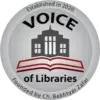Enquiries desk انکوائری ڈیسک
The enquiries desk (previously known as the lending desk) is a desk or counter at a library where users can ask questions, get help with finding materials, and request services such as borrowing books or using computers. It is typically staffed by librarians or other library staff who are trained to assist patrons with their research and information needs. The enquiries desk is often the first point of contact for users when they enter the library, and it is typically located in a prominent place in the library. At some libraries, the enquiries desk is also known as the circulation desk, as it is often responsible for managing the circulation of materials, such as lending books to patrons and managing reservations and holds.
Enquiries desk انکوائری ڈیسک Read More »
